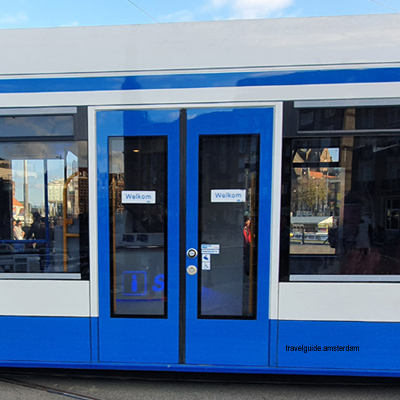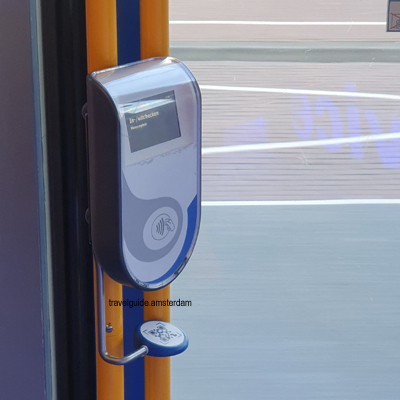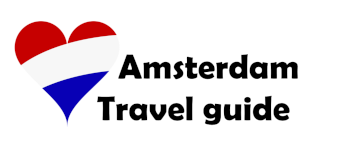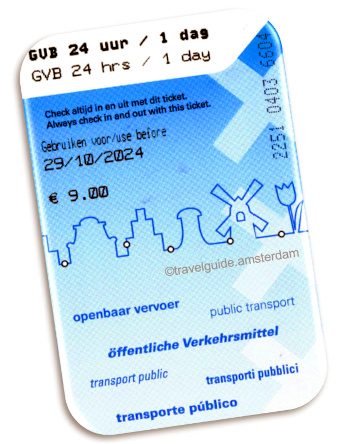The tram in Amsterdam:
info, tickets, route plan & tips for passengers
Compared to the Metro, the tram in Amsterdam has a much denser network of lines and stops. The tram is operated by the municipal transport company GVB, which also organizes Metro, city buses, and ferries.
In this guide you will find information for passengers and practical tips for using the streetcar in Amsterdam.
Klicke hier, um Ihren eigenen Text einzufügen

The tram is a good way to discover Amsterdam. Thanks to a dense network of stops and lines, you can reach many destinations and sightseeing highlights. (Image: travelguide.amsterdam)
The tram network: lines and network map
The tram network has been expanding since 1875 and nowadays encompasses 15 lines and approximately 200 km of rail lines.
→ Download:
map – tram lines in Amsterdam / route network plan (as of 2023 / 2024):
Tips for passengers & sightseeing by tram
- Since 2018 cash purchases of tickets onboard the tram are no longer possible. You will find more info under “Which ticket option is best for me?” (see below).
It is worth it to research tickets for mass transit ahead of time. That saves time and money later. - A not-so-secret-anymore tip is the tram line number 2. It is popular with sightseeing tourists, as many of its stops are nearby attractions. This line will get you to the flower market, Royal Palace on the dam, Rijksmuseum, Van Gogh museum, Stedelijk museum for example and passing through all the canals of Amsterdam’s famous Canal Belt.
- Getting on and off: You may only enter the tram at the front door by the driver or at the double doors at the back. The other doors are for exit only. After entering the tram, you have to validate your ticket on the checking device. A valid ticket is also required to exit.
- The streetcar is often used by tourists. In contrast to the underground metro, you can also discover the city during the journey. Thanks to the dense network of lines, many sightseeing highlights and museums can be reached by streetcar.

Only the doors with the “Welkom” sticker are for entry. (Image: travelguide.amsterdam)

After boarding, you must present your ticket here. The validity is checked (Image: travelguide.amsterdam)
Tickets for the public transport system in Amsterdam:
Which ticket option is best for me?
Whether single ride via e-purse, also referred to as OV-card, all-day ticket, “I Amsterdam Card”, or “Amsterdam Travel Card”, you will find detailed information for all, as well as current fares here.
It allows you to quickly and easily find the right ticket option for your stay in Amsterdam. Researching all options upfront and knowing which ticket option works best for you, will save you money and time after arrival and prevent stressful situations.
Our advice – when you don’t want to deal with the tariff system and ticket machines:
The single-day or multi-day tickets that are available for the public transport system in Amsterdam are typically the best choices for visitors.
These tickets allow unlimited use of the Metro (subway), GVB bus system, trams, as well as ferries for the entire period of validity (1 – 7 days).
These tickets are rather inexpensive for a European metropolitan city.
For 2024 fares range between €5.85 and €9 a day, depending on period of validity
You can purchase these tickets online before your trip without additional fees via the English-language website of the authorised GVB ticket seller – click here –. You will not have to deal with ticket machines or the tariff system upon your arrival.
That saves time and nerves – after all, you will have better things to do in Amsterdam…
Tram lines in Amsterdam – overview:
| line | from – to | important stops |
| 1 | Muiderpoortstation – Osdorp De Aker (Matterhorn) | Weesperplein, Leidseplein, Surinameplein, Station Lelylaan |
| 2 | Centraal Station – Nieuw Sloten (Oudenaardeplantsoen) | Leidsestraat, Museumplein, Hoofddorpplein |
| 3 | Zoutkeetsgracht – Flevopark | Museumplein, Ceintuurbaan, Muiderpoortstation |
| 4 | Centraal Station – Station RAI (Drentepark) | Utrechtsestraat, Frederiksplein |
| 5 | Westergasfabriek (Van Hallstraat) – Stadshart Amstelveen | Leidseplein, Museumplein, Station Zuid |
| 7 | Slotermeer (Sloterpark) – Azartplein | Mercatorplein, Leidseplein, Weesperplein, Rietlandpark |
| 12 | Centraal Station (Hauptbahnhof) – Amstelstation | Leidsestraat, Museumplein, Ceintuurbaan, Churchill-laan |
| 13 | Centraal Station – Geuzenveld (Lambertus Zijlplein) | Rozengracht, Mercatorplein |
| 14 | Centraal Station – Flevopark | Dam, Plantage, Borneostraat |
| 17 | Centraal Station – Osdorp Dijkgraafplein | Rozengracht, Kinkerstraat, Station Lelylaan |
| 19 | Station Sloterdijk – Diemen Sniep | Admiraal de Ruijterweg, Leidseplein, Weesperplein, Watergraafsmeer |
| 24 | Centraal Station – VU medisch centrum (De Boelelaan/VU) | Vijzelstraat, Ferdinand Bolstraat, Ceintuurbaan, Beethovenstraat, Stadionweg, Amstelveenseweg |
| 25 | Station Zuid – Amstelveen Westwijk | Buitenveldertselaan, Beneluxbaan |
| 26 | Centraal Station – IJburg (Pampuslaan) | Passagiersterminal, Rietlandpark, Piet Heintunnel |
| 27 | Surinameplein – Osdorp Dijkgraafplein | Station Lelylaan |
A few words about the history of the streetcar in Amsterdam

Amsterdam’s first horse streetcar was opened in 1875. Today, the city’s public transport company GVB operates the streetcar.
The history of streetcars in Amsterdam dates back to the 19th century, when the first horse-drawn streetcars were introduced in the city. The first electric streetcars were then put into operation at the beginning of the 20th century and played an important role in the city’s public transportation system.
Decline and revival
In the 1950s and 1960s, there was a decline in tram use as many people switched to cars. This led to a reduction in the streetcar network, but in the 1980s the city began to modernize and expand the streetcar infrastructure.
FAQ 2024
Is there a tram in Amsterdam?
Yes, Amsterdam has a well-developed tram network. The tram is a good way to discover the city. Thanks to many stops and lines you can reach many destinations. You can find more tips and information in our travel guide.
How much does a tram ticket cost in Amsterdam 2024?
There is no classic single ticket for Amsterdam public transport. Single journeys can be paid for with the “OV / E-Purse card”. It works in a similar way to a prepaid mobile phone card. You can load an amount of money onto this card at a machine. You can then use this credit to pay for local transport. A reloadable, anonymous e-purse card (without passport photo) costs 7.50 euros (without credit).
It is easier to use local transport with a day or multi-day ticket.




I was just on a holiday and I forgot my backpack on your number 4 tram line, was just hoping if anyone may have turned it in? It is an all black Amazon backpack with a blue dell lab top ray ban sunglasses and a blue tooth selfie stick, if I was turned in I’d be ever so greatfull if it’s found! PEACE AND BLESSINGS!
Hello Gordon,
We’re sorry to hear that you had such a mishap while on vacation. Please contact the lost property office of the local public transport company GVB directly.
Good luck